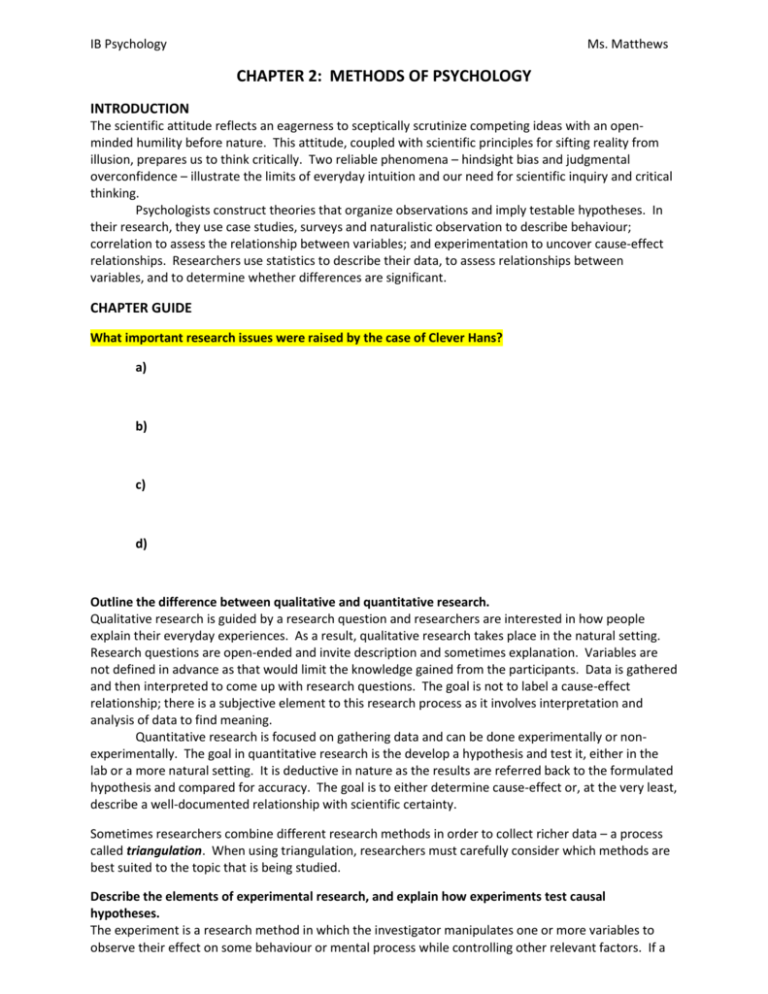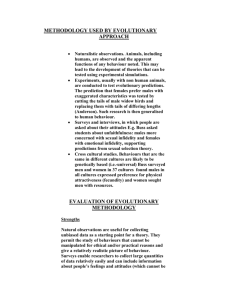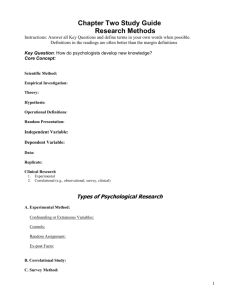Chapter 2 Methods of Research Revision Guide.doc
advertisement

IB Psychology Ms. Matthews CHAPTER 2: METHODS OF PSYCHOLOGY INTRODUCTION The scientific attitude reflects an eagerness to sceptically scrutinize competing ideas with an openminded humility before nature. This attitude, coupled with scientific principles for sifting reality from illusion, prepares us to think critically. Two reliable phenomena – hindsight bias and judgmental overconfidence – illustrate the limits of everyday intuition and our need for scientific inquiry and critical thinking. Psychologists construct theories that organize observations and imply testable hypotheses. In their research, they use case studies, surveys and naturalistic observation to describe behaviour; correlation to assess the relationship between variables; and experimentation to uncover cause-effect relationships. Researchers use statistics to describe their data, to assess relationships between variables, and to determine whether differences are significant. CHAPTER GUIDE What important research issues were raised by the case of Clever Hans? a) b) c) d) Outline the difference between qualitative and quantitative research. Qualitative research is guided by a research question and researchers are interested in how people explain their everyday experiences. As a result, qualitative research takes place in the natural setting. Research questions are open-ended and invite description and sometimes explanation. Variables are not defined in advance as that would limit the knowledge gained from the participants. Data is gathered and then interpreted to come up with research questions. The goal is not to label a cause-effect relationship; there is a subjective element to this research process as it involves interpretation and analysis of data to find meaning. Quantitative research is focused on gathering data and can be done experimentally or nonexperimentally. The goal in quantitative research is the develop a hypothesis and test it, either in the lab or a more natural setting. It is deductive in nature as the results are referred back to the formulated hypothesis and compared for accuracy. The goal is to either determine cause-effect or, at the very least, describe a well-documented relationship with scientific certainty. Sometimes researchers combine different research methods in order to collect richer data – a process called triangulation. When using triangulation, researchers must carefully consider which methods are best suited to the topic that is being studied. Describe the elements of experimental research, and explain how experiments test causal hypotheses. The experiment is a research method in which the investigator manipulates one or more variables to observe their effect on some behaviour or mental process while controlling other relevant factors. If a behaviour changes when we vary an experimental factor, then we know the factor is having a causal effect. Population = Sample = Operational definition = Independent variable = Dependent variable = Experimental group = Control group = Placebo = Placebo effect = Random assignment = Experimenter bias = Hawthorne effect = Double blind research = Explain the strengths and limitations of correlational research. Discuss the aims of descriptive studies. Descriptive studies simply describe a set of facts rather than looking for relationships between facts. Descriptive studies cannot be used to predict future potential; they simply describe a state as it exists at one point in time. Compare the advantages and disadvantages of laboratory research and field studies. Research done in a laboratory has an advantage in that the setting is specifically designed for research to be carried out and variables can be controlled so as not to influence the manipulation of the independent variable (eg. limits confounding variables). This allows us to have a high degree of confidence in drawing causal relationships between variables (if all experimental safeguards are followed). Labs also allow for easy replication of an experiment, which aids in the validity of our findings. However, lab settings do not measure behaviour as it actually occurs so there is a certain degree of artificiality to them. Field studies present behaviour in its natural context so they lack the artificial manipulation of labs and, as a result, may be more representative of reality. However, field studies do not allow us to control for confounding variables or other conditions that may influence the results we see so we are not always confident in drawing causal relationships between variables. Describe the purposes of self-report strategies, outlining both its advantages and limitations. Self-report strategies, or surveys, look at many cases in less depth and ask people to report their behaviour and opinions. Asking questions is tricky because even subtle changes in the order or wording of questions can dramatically affect responses. In everyday experience, we are exposed to a biased sample of people who mostly share out attitudes and habits. As a result, we are vulnerable to the false consensus effect, whereby we overestimate others’ agreement with us. The survey ascertains the selfreported attitudes or behaviours of a population, by questioning a representative, random sample. However, the extent to which individuals responses are honest and therefore accurate is questionable, thereby influencing the accuracy of the reported results. Describe the purpose of observational methods, outlining both its advantages and limitations. Observational research, also known as naturalistic observation, consists of observing and recording the behaviour of organisms in their natural environment. This allows the researcher to see genuine behaviour, rather than behaviour impacted by the very act of knowingly being observed. It must be done covertly to ensure this genuine aspect. This research strategy describes behaviour as it occurs; however, it does not explain behaviour. Distinguish between descriptive and inferential statistics. Descriptive statistics are used to describe or summarize data from studies to make them easier to understand. Descriptive statistics can consist of measures of central tendency, measures of variability or simple correlational coefficients. Inferential statistics help us analyze data collected and make predictions about what is likely to happen in the future or what trends we are likely to see in the larger population. Inferential statistical tests can include those such as the Chi Squared Test, the MannWhitney U Test, or the T-Test. Describe how the common measures of central tendency and variability help describe a set of numbers and demonstrate how to calculate these values. Measures of central tendency: a) Mean = b) Median = c) Mode = Measures of variability: a) Standard deviation = b) Range= c) Variance = Explain the concept of correlation. A correlation is simply a relationship between two variables or facts. Correlation cannot prove causation as there may be another factor (or factors) that the researcher is unaware of that is influencing the relationship that is being seen. Describe how a correlation coefficient represents the strength and direction of a relationship. A correlation coefficient tells us the direction an strength of a relationship between two variables. The closer the number is to either positive or negative 1, the stronger the relationship between the two variables. 1-------------------------------------------------------------0-------------------------------------------------------------------1 Describe the various types of correlation seen in a scatterplot. When surveys and naturalistic observations reveal that one trait or behaviour accompanies another, we say the two correlate. A correlation coefficient is a statistical measure of a relationship. A positive correlation indicates a direct relationship, meaning two things increase together or decrease together. A negative correlation indicates an inverse relationship, meaning that as one thing increases the other decreases. Researchers depict scores on graphs called scatterplots; each point plots the value of two variables. The correlation coefficient helps us to see the world more clearly by revealing the extent to which two things relate. Positive correlation Negative correlation Zero correlation Describe how people form illusory correlations. Illusory correlation, the perception of a relationship where none exists, often occurs because our belief that a relationship exists leads us to notice and recall confirming instances of that belief. Because we are sensitive to unusual events, we are especially likely to notice and remember the occurrence of two such events in a sequence; for example, a premonition of an unlikely phone call followed by that call. What does it mean when we say that “results are statistically significant at the 5 percent level”? Significance levels are expressed as a decimal in the form of P< 0.05 where P stands for the probability that chance factors are responsible for results. Psychologists have concluded that for most purposes in psychology, the 5% level of significance is appropriate. A result that is significant at this level can be said to be less than 5% likely to be due to chance factors. Describe ways in which bias can enter in to research. a) Biased sample: when members of a sample differ in a systematic way from the larger population the researcher is interested in b) Observer-expectancy effect: the researcher has expectations that influence the measurements they make or the data they collect (experimenter bias) c) Subject-expectancy effect: the subject knows the design and tries to produce the expected result (participant bias) Explain the importance of proper sampling in research and how it relates to the generalizability of research conclusions. Describe how error and bias relate to the reliability and validity of measurement procedures, and suggest how validity can be assessed. Describe some ethical issues in psychological research and outline the basic APA guidelines for both human and animal research. Issues in research exist around consent of subjects to participate in research, deception, confidentiality, hidden observations, the right to withdraw and debriefing of participants. When dealing with people in research we have to respect the following rights as outlined by the APA (American Psychological Association): 1. Informed consent – the individual has to be told, to the best ability of the researcher, the purpose of the study, including whether or not deception may be present in the study. 2. Deception – Deception can only be used when it is absolutely necessary; the researcher must be convinced it is the only way to achieve the desired results. 3. Confidentiality – participants are entitled to confidentiality, especially when we are dealing with case studies. 4. Withdrawal – at any time, participants must be free to withdraw from the study, if they desire, with no penalty. Coercion cannot be used to keep participants in a study against their will. 5. Debriefing – once the study is completed, the researcher is to fully debrief participants on the results of the research, their behaviour within the research and the nature of any deception used as well as why it was imperative to use it 6. Protection of participants – always, the researcher must refrain from causing undue harm (physical, emotional) to human participants. Guidelines for animal research include the following: 1. Avoid or minimize stress and suffering for all living animals 2. Always consider the possibility of other options to animal research 3. Be as economical as possible in the numbers of animals tested. Where research on animals cannot be avoided, the following conditions are monitored: The conditions under which animals are kept – cage sizes, food, lighting, temperature, care routine, etc. have to be suitable for the species and its habits The researchers conducting the research – all involved have to demonstrate they have the necessary skills and experience to work with the particular species they wish to study The research projects allowed – applications must be submitted outlining project aims, and possible benefits, as well as the procedures involved and number of animals and the degree of distress they might experience. The level of distress caused to the animals must be justified by the benefits of the research in order for approval to be gained Differentiate between cross-sectional studies, longitudinal studies and cross-cultural studies. Cross-sectional studies are those in which subjects of different ages are investigated at one particular point in time (eg. Asch’s study of conformity) Advantages Disadvantages Longitudinal studies are those in which the same subjects are investigated over a long period of time at specific intervals. Advantages Disadvantages Cross-cultural studies are those in which subjects from different cultures are given the same test and their results are compared (eg. Mead’s studies of gender role across tribes in New Guinea) Advantages Outline the issues around ethnocentrism in research: Disadvantages






